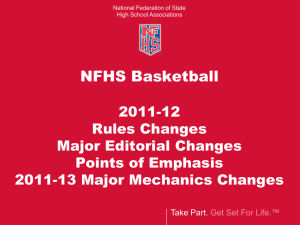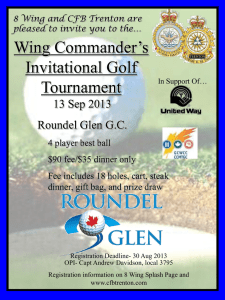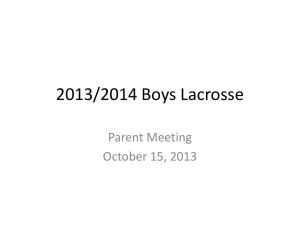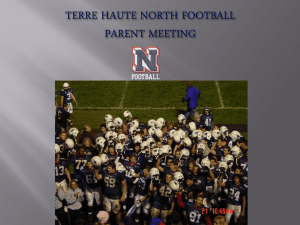Rule 5 Presentation: Personal and Ejection Fouls
advertisement
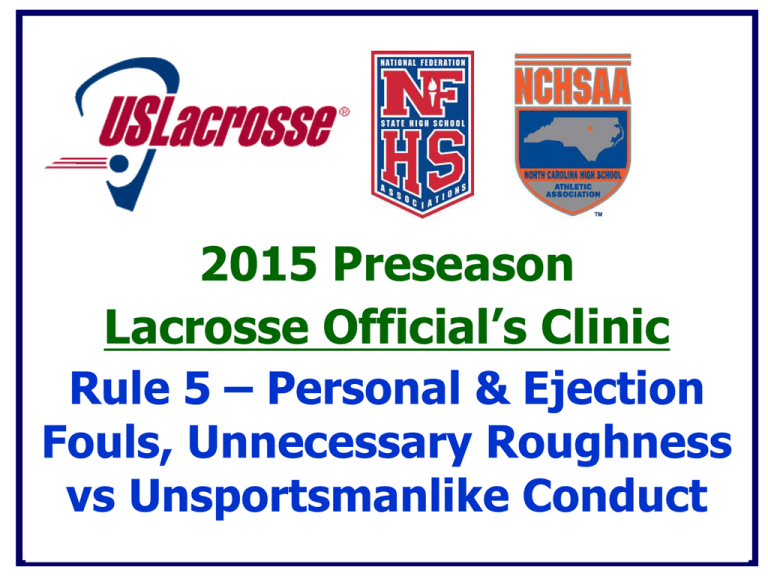
2015 Preseason Lacrosse Official’s Clinic Rule 5 – Personal & Ejection Fouls, Unnecessary Roughness vs Unsportsmanlike Conduct CONSISTENCY Topics for 2015 Face-Offs Coaches – Unnecessary Roughness vs. Unsportsmanlike Conduct – Restarts in Defensive End – Off Ball Movement – Simultaneous Fouls – Illegal Crosses Rule 5 Personal and Ejection Fouls (Page 55 in NFHS 2015 Rules Book) Section 1 – Personal Fouls Personal fouls are those of a serious nature: illegal body checking, slashing, cross-checking, tripping, unnecessary roughness, unsportsmanlike conduct, checks involving the head/neck and the use of an illegal crosse and/or illegal equipment. Penalty: The penalty for a personal foul shall be suspension from the game of the offending player for one to three minutes, depending on the official's judgment of the severity and perceived intent of the personal foul. The ball shall be given to the team fouled. That’s Personal! Rule 5 Personal and Ejection Fouls Personal Fouls We’ll discuss each foul in terms of: Foul Definition Penalty Signal Key things to look for Picture of foul Discussion points related to levels Rule 5 Personal and Ejection Fouls (Page 55 in NFHS 2015 Rules Book) In General … See the beginning, See the middle and See the end. It might start out looking like one thing and end up something else, or nothing. Cross-Check (Page 55 in NFHS 2015 Rules Book) A player may not check his opponent with his crosse in a cross-check position. That is, a check with that part of the handle of the crosse that is between the player's hands, either by thrusting away from the body or by holding it extended from the body. Two keys: (1) position of defensive player’s hands on cross (2) thrusting or extension of the cross Cross-Check (Page 55 in NFHS 2015 Rules Book) Penalty: • One to three minutes depending on the official's judgment of the severity and perceived intent of the personal foul. • If targeting the head/neck – minimum of 2-minutes (can be 3-minutes), non-releasable,. • If excessively violent … ejection. Signal: Cross-Check (Page 55 in NFHS 2015 Rules Book) Key Things to Look For: Two keys: (1) Defensive players hands apart on the shaft; ask yourself … are his hands apart? and (2) Thrusting of the cross, or cross extended, resulting in contact made with shaft Preventative Mechanic: “Hands together 44, stay off his back” Cross-Check (Page 55 in NFHS 2015 Rules Book) Cross-checks have the potential for serious injury at all levels of play. A few years ago, there were officials, with years and years of experience, who said there was a cross-check on every play. We have collectively done a better job, at all levels, making this call and it is now less prevalent; but cross-checks still occur quite often. Cross-Check (Page 55 in NFHS 2015 Rules Book) What’s your call? Hands? Thrust? Extension? Contact with shaft? Cross-Check (Page 55 in NFHS 2015 Rules Book) What’s your call? Hands? Contact with shaft? Could this be something else? Penalty Time? Cross-Check (Page 55 in NFHS 2015 Rules Book) What’s your call? Hands? Contact with shaft? Could this be something else? Penalty Time? Cross-Check (Page 55 in NFHS 2015 Rules Book) Differences based on level of play: High School Varsity High School JV Middle School U15 U13 U11 U9 Note: Cross-checks have the potential for serious injury at all levels of play. Illegal Body-Check (Page 55 in NFHS 2015 Rules Book) ART. 1 . . . Body-checking of an opponent who is not in possession of the ball or within 5-yards of a loose ball. (NOTE: for all youth levels this is 3-yards.) ART. 2 . . . Body-checking of an opponent from the rear or at or below the waist. ART. 3 . . . Body-checking of an opponent who has any part of his body other than his feet on the ground. Illegal Body-Check (Page 55 in NFHS 2015 Rules Book) Art. 4 . . . If a player who is about to be bodychecked turns his back, jumps or moves in such a manner to make what started out to be a legal check appear illegal, no foul is committed by the player applying the body-check. Art. 5 . . . A body check that targets a player in a defenseless position. This includes but is not limited to: (i) body checking a player from the blind side, (ii) body checking a player that has his head down, (iii) body checking a player whose head is turned away to receive a pass, even if that player turns toward the contact immediately before the body check. Illegal Body-Check (Page 55 in NFHS 2015 Rules Book) Penalty: • One to three minutes depending on the official's judgment of the severity and perceived intent of the personal foul. • Penalty for violation of Article 5 (defenseless player) is a two or three-minute non-releasable foul, at the official’s discretion. • If excessively violent … ejection. Signal: Illegal Body-Check (Page 55 in NFHS 2015 Rules Book) Key Things to Look For: More than 5-yards from a loose ball (3-yards for Youth) Late hit after pass or shot From the back/rear At or below the waist (butt, thighs, hips) Any part of opponent’s body, other than his feet, on the ground. (knee, hand, etc) Defenseless position: blind side, head down, buddy pass … even if that player turns toward the contact immediately before the body check. Illegal Body Check? (Page 55 in NFHS 2015 Rules Book) What’s your call? What if white player turned? Could this be something else? Penalty Time? Illegal Body Check? (Page 55 in NFHS 2015 Rules Book) What’s your call? Illegal Body Check? (Page 55 in NFHS 2015 Rules Book) What’s your call? What if white player turned? Could this be something else? Penalty Time? Illegal Body Check (Page 55 in NFHS 2015 Rules Book) Differences based on level of play: High School Varsity High School JV Middle School U15, U13, U11 & U9: TAKE-OUT CHECKS/EXCESSIVE BODY CHECKS are prohibited at every age level. A take-out/body check is defined as: a) Any body-check in which the player lowers his head or shoulder with the force and intent to put the other player on the ground. b) Any body-check considered more aggressive or more physical than necessary to stop the advancement of the player carrying the ball or to keep or move a player away from a loose ball. Including but not limited to: (i) force sufficient to knock down a player, (ii) sufficient force and intent to injure a player, and (iii) reckless or intimidating manner. Penalty: 2 or 3 minute non-releasable personal foul at the official’s discretion. If excessively violent, possible ejection. Checks Involving the Head/Neck (Page 56 in NFHS 2015 Rules Book) ART. 1 . . . A player shall not initiate contact to an opponent's head or neck with a cross-check, or with any part of his body (head, elbow, shoulder, etc.). Any followthrough that contacts the head or neck shall also be considered a violation of this rule. ART. 2 . . . A player shall not initiate an excessive, violent or uncontrolled slash to the head/neck. ART. 3 . . . A player, including an offensive player in possession of the ball, shall not block an opponent with the head or initiate contact with the head (known as spearing). PENALTY: Two- or three-minute non-releasable foul, at the official's discretion. An excessively violent violation of this rule may result in an ejection. Illegal Cross (Page 56 in NFHS 2015 Rules Book) Use of an illegal crosse carries a one- or three-minute nonreleasable penalty. An illegal crosse due to a deep pocket will carry a oneminute non-releasable penalty. An illegal crosse because it was altered to gain an advantage: three-minute non-releasable penalty … and the illegal crosse will remain in the table area for the remainder of the game. Every crosse on a team is subject to inspection, and the crosse need not have been in the game to be inspected. If you can fix it … 1-Minute; if you can’t … 3-Minutes Illegal Cross (Page 12 in NFHS 2015 Rules Book) Illegal Cross (Page 12 in NFHS 2015 Rules Book) Illegal Cross (Page 12 in NFHS 2015 Rules Book) Illegal Cross – Situation Review (Page 57 in NFHS 2015 Rules Book) Situation C: During the game, an official inspects the equipment of a player and finds that the longitudinal weaving of the crosse is not firmly attached to bottom edge of the throat-stop construction. Ruling? Situation D: During the game, an official asks a player for his crosse so the official can check it. Before the player hands the crosse to the official, he adjusts the strings or jams the crosse. Ruling? Situation G: A3 scores a goal by kicking the ball into goal. Before the next whistle, the opposing head coach requests an equipment inspection on A3. Ruling? Illegal Cross – Situation Review (Pages 57-58 in NFHS 2015 Rules Book) Situation I: During the crosse inspection, the officials discover that the ball does not roll freely from the pocket, with the ball either remaining in the pocket when the head is rotated toward the ground or the ball sticking momentarily before rolling out. RULING: 3:00 non-releasable penalty and the stick is removed from the game whether the ball is being held by the head or by the stringing. COMMENT: If the pocket is too deep and the officials feel that the pocket depth is the reason the ball will not release, a 1:00 non-releasable penalty may be assessed and the crosse may return if adjusted. Illegal Cross – Equipment Checks Level of play: High School Varsity – One per half, also at coach request High School JV – One per half, also at coach request Middle School – One per half, also at coach request U15 U13 U11- crosse length for field players: 37” – 42” or 47” – 54” U9 – all crosse length for field players: 37” – 42” Illegal Equipment (Page 58 in NFHS 2015 Rules Book) Section 6 – A player may not use equipment that does not conform to specifications. The fingers/palms of a player's hands must be completely covered by his gloves and the gloves may not be altered in a way that compromises their protective features. Use of illegal equipment or failure to properly wear required equipment will be penalized as a nonreleasable foul. What’s your call: Holes in gloves? Not wearing arm pads? “Coach, are you aware that the Cascade Model R, if not recertified, and Warrior Regulator helmet models do not meet the NOCSAE standard for lacrosse at this time and they are not legal for play?” Slashing (Page 58 in NFHS 2015 Rules Book) ART. 1 . . . Swinging a crosse at an opponent's crosse or body with deliberate viciousness or reckless abandon, regardless of whether the opponent's crosse or body is struck. ART. 2 . . . Striking an opponent in an attempt to dislodge the ball from his crosse, unless the player in possession, in an attempt to protect his crosse, uses some part of his body other than his head or neck to ward off the thrust of the defensive player's crosse and, as a result, the defensive player's crosse strikes some part of the attacking player's body other than his head or neck. ART. 3 . . . Striking an opponent in any part of the body with the crosse (including its end cap), except when done by a player in the act of passing, shooting or attempting to scoop the ball. In all situations, the player's gloved hand shall be considered part of the crosse, except when in contact with a line marking. Slashing (Page 59 in NFHS 2015 Rules Book) 5.7.1 Situation: B1, while playing A1, makes contact on A1’s head with his crosse. RULING: Contact itself does not constitute a foul. The contact shall be a definite blow or strike. Otherwise, it is considered a brush. 5.7.3 Situation C: A1, advancing toward B1, holds his crosse back with one hand and protects his crosse with the other arm. B1 then swings his crosse and strikes A1’s protecting arm. RULING: Personal foul; slashing against B1. 5.7.3 Situation D: A3 has beaten B2, who swings his stick in a check and strikes A3 on the shoulder or across the back in an attempt to get at A3’s stick. RULING: Slashing. This is an illegal back check. Slashing (Page 58 in NFHS 2015 Rules Book) Penalty: • One to three minutes depending on the official's judgment of the severity and perceived intent of the personal foul. • If targeting the head/neck – minimum of two-minutes, non-releasable • If excessively violent … ejection. Signal: Slashing (Page 58 in NFHS 2015 Rules Book) Key Things to Look For: There is no such thing as one free whack or warning Repeated striking of free hand (beat the hand to death) Hitting opponent on: shoulder, thigh, arm, upper arm, hip Tomahawk, One-handed, wild swing, Retaliation, Loose ball Offensive player executes a face dodge, defensive player hits his midsection Defensive player gets beat, slash to back Preventative Mechanic: “Get stick 44, get stick” Slashing? What’s your call? Could this be something else? Penalty Time? Slashing? What’s your call? Slashing? http://www.youtube.com/watch?v=Or3qeBiKRUI&feature=player_detailpage What’s your call? Could this be something else? Penalty Time? Slashing? What’s your call? Slashing Differences based on level of play: High School Varsity: brush vs strike/blow High School JV: brush vs strike/blow Middle School: almost any contact to head, arms, etc U15, U13, U11 & U9: Any one-handed check shall be considered a slash, whether or not it makes contact with the opposing player. NOTE: If the defensive player’s hand comes off his stick in his legitimate follow-through motion after, or during recovery from, a controlled poke check, this need not be considered a slash solely because his hand came off the stick. Tripping (Page 59 in NFHS 2015 Rules Book) A player may not trip an opponent with any part of his body or crosse. Tripping is obstructing an opponent at or below the waist with the crosse, hands, arms, feet or legs, by any positive primary action if the obstructing player is on his feet or by any secondary action when the obstructing player is not on his feet. When a player legally checks the crosse of a opponent and the result is to cause the opponent to trip over his own crosse, no foul is committed. Similarly, if an opponent falls over a player's crosse when that player is attempting to scoop a loose ball, no foul has been committed. Tripping (Page 59 in NFHS 2015 Rules Book) Penalty: In almost all cases, one minute. Signal: Tripping (Page 59 in NFHS 2015 Rules Book) Key Things to Look For: 5.8.1 Situation A: A1, while dodging B1, falls over B1’s stationary leg. RULING: Legal; this is not tripping. 5.8.1 Situation B: B1, while playing A1, swings his leg around as A1 is dodging him, causing A1 to stumble or fall to the ground. RULING: Personal foul for tripping. Tripping? What’s your call? Could this be something else? Penalty Time? Tripping What’s your call? Could this be something else? Penalty Time? Tripping What’s your call? Could this be something else? Penalty Time? Tripping (Page 59 in NFHS 2015 Rules Book) Differences based on level of play: High School Varsity High School JV Middle School U15 This penalty is seen more often at the lower levels of play; but does occur at all levels. U13 U11 U9 A trip is a trip regardless of level. Unnecessary Roughness (Pages 59, 60 in NFHS 2015 Rules Book) ART. 1 . . . An excessively violent infraction of the rules against holding and pushing. ART. 2 . . . Deliberate and excessively violent contact made by a defensive player against an offensive player who has established a screening position. ART. 3 . . . Any avoidable act on the part of a player that is deliberate and excessively violent, whether it be with the body or crosse. This may include a legal body check. ART. 4 . . . A check delivered with the gloved hand or hands may not be delivered with a punching blow. This is mostly a judgment call and often used for game management. Unnecessary Roughness (Pages 59, 60 in NFHS 2015 Rules Book) 5.9.2 Situation: B1 is playing A1. A1, running at full speed, cuts around A2, who had set up a screening position. B1, while playing A1, contacts A2 violently. RULING: Legal, if B1 was concentrating on A1. Illegal, if B1 deliberately ran into A2, which would be a personal foul. Look at the defensive player’s eyes and shoulders. Did he intentionally “blast” through the pick to level the opponent or simply run into him? Unnecessary Roughness (Pages 59, 60 in NFHS 2015 Rules Book) 5.9.3 Situation D: B1 is substituting on the fly. B2 enters the field of play correctly under the special substitution rule and immediately body checks A1, who is vulnerable. RULING: Unnecessary roughness if the check was avoidable. 5.9.3 Situation E: A1 with possession of the ball advances toward stationary defender B1 and with a bull-dodge runs over B1. RULING: Unnecessary roughness if A1’s actions were deliberate and excessively violent. Unnecessary Roughness (Pages 59, 60 in NFHS 2015 Rules Book) Penalty: One to three minutes depending on the official's judgment of the severity and perceived intent of the personal foul. Signal: Unnecessary Roughness (Pages 59, 60 in NFHS 2015 Rules Book) Penn State's Shane Sturgis, left, takes a check from Hofstra's Cody Solaja, right, after taking a shot on goal. Solaja was called for unnecessary roughness. Unnecessary Roughness (Pages 59, 60 in NFHS 2015 Rules Book) Differences based on level of play: High School Varsity High School JV Middle School U15, U13, U11, U9: PENALTY – Any penalty for Unnecessary Roughness shall be non-releasable. Unsportsmanlike conduct (Pages 60, 61 in NFHS 2015 Rules Book) No player, substitute, nonplaying member of a squad, coach or anyone officially connected with a competing team shall: a. Enter into an argument with an official as to any decision that has been made or in any way attempt to influence the decision of an official. b. Use threatening, profane or obscene language or gestures at any time during the game. c. Bait or call undue attention to oneself, or any other act considered unsportsmanlike by the officials. d. Deliberately use his hand or fingers to play the ball or grab an opponent’s crosse with the open hand or fingers. Note: Inadvertent touching of the ball when the hand is grasping the stick should not be called as an unsportsmanlike conduct foul. PENALTY: Items above are one- to three-minute non-releasable penalties in all cases. Unsportsmanlike conduct (Pages 60, 61 in NFHS 2015 Rules Book) e. Repeatedly commit the same technical foul. f. As a player, deliberately fail to return immediately to the field after leaving the field of play while legally in the game. g. As a substitute, deliberately fail to comply with the rules for entering the field of play. PENALTY: Items above are one- to three-minute releasable penalties in all cases. Unsportsmanlike conduct (Pages 60, 61 in NFHS 2015 Rules Book) Situations Review: 5.10.1 Situation A: B1 fouls A1. The official assesses a oneminute penalty. B1 then maligns the official and receives an additional two-minute unsportsmanlike conduct penalty. Does a goal by A1 wipe out B1’s personal foul (nonmaligning)? What’s your call? 5.10.1 Situation B: B1 slashes A1 and receives a two-minute personal foul. During the same play, B2 maligns the official and receives a one-minute unsportsmanlike penalty. What’s your call? 5.10.1 Situation C: A1 takes a position in front of crease area and as A2 takes a shot (a) A1 is facing toward A2 or (b) A1 is facing goalkeeper. A1 waves his hands and crosse back and forth. What’s your call? Unsportsmanlike conduct (Pages 60, 61 in NFHS 2015 Rules Book) Situations Review: 5.10.1 Situation D: B1 drops his crosse, then secures an opponent’s crosse and continues to play. What’s your call? CONSISTENCY Unnecessary Roughness vs Unsportsmanlike Conduct • Definitions • Examples • Ramifications • Alternatives CONSISTENCY Unnecessary Roughness vs Unsportsmanlike Conduct Definitions – Unnecessary = Not Needed – Conduct = Personal Behavior CONSISTENCY Unnecessary Roughness vs Unsportsmanlike Conduct Examples U R – Excessively violent hold or push (IBC?), defenseless player, late hit, hit on a pick. U C – Argue w/ official, baiting or taunting, profane language, use hands on face-off Releasable – Repeated technical fouls, fail to return to field, fail to comply with substitution rules. CONSISTENCY Unnecessary Roughness vs Unsportsmanlike Conduct Ramifications U R – Defenseless player = 2 min. nonreleasable (minimum), are we removing contact from the game? U C – Second equals ejection CONSISTENCY Unnecessary Roughness vs Unsportsmanlike Conduct Alternatives U R – Illegal body check, add releasable penalty time (2 or 3 minutes) U C – Conduct foul, preventive officiating (talk them out of it before it happens) Fouling Out (Pages 61, 62 in NFHS 2015 Rules Book) Any player who accumulates five minutes of personal fouls shall be disqualified from the game. A substitute for that player may enter the game when the disqualified player would have been permitted to re-enter had he not fouled out. A player who accumulates five minutes of personal fouls has fouled out of the game but has not been ejected. (Note: Youth rules are different: 4 personal fouls or 5 minutes.) Ejection (Page 62 in NFHS 2015 Rules Book) ART. 1 . . . A player, substitute, coach, nonplaying member of a team or anyone officially connected with the team shall be ejected for: a. Deliberately striking or attempting to strike anyone or leaving the bench area during an altercation. b. Use of tobacco or smokeless tobacco. c. Second non-releasable, unsportsmanlike foul. d. Any action deemed by the officials to be flagrant misconduct. Ejection (Page 62 in NFHS 2015 Rules Book) NOTE: The NFHS disapproves of any form of taunting which is intended or designed to embarrass, ridicule or demean others under any circumstances including on the basis of race, religion, gender or national origin. PENALTY: Three-minute non-releasable penalty and ejection for the remainder of the game. The ejected coach shall be removed from the premises (bench and field area). The ejected player, substitute or non-playing team member shall be removed from the premises if there is authorized school personnel present to supervise the ejected student. If no authorized school personnel is available, the student shall be confined to the bench area. The officiating assigning authority is responsible for notifying the appropriate school of the ejection. Ejection: NCHSAA (NCHSAA Website: www.nchsaa.org) NCHSAA SPORTSMANSHIP/EJECTION POLICY This policy applies to all persons involved in an athletic contest, including student-athletes, coaches, managers and game administrators. The following examples include behavior or conduct which will result in an ejection from a contest: 1. Fighting, which includes, but is not limited to, combative acts such as: *An attempt to strike an opponent with a fist, hands, arms, legs or feet *An attempt to punch or kick an opponent, regardless of whether or not contact is made *An attempt to instigate a fight by committing an unsports-manlike act toward an opponent that causes an opponent to retaliate *Leaving the bench area to participate in a fight (contact or no contact) Ejection: NCHSAA (NCHSAA Website: www.nchsaa.org) 2. Biting observed by an official 3. Taunting, baiting or spitting toward an opponent 4. Profanity, directed toward an official or opponent 5. Obscene gestures, including gesturing in such a manner as to intimidate 6. Disrespectfully addressing (physically contacting an official is subject to automatic expulsion and can result in ineligibility for remainder of career) an official Penalty for an ejection for the above reasons: *All other sports - ejection from that contest; miss the next two contests at that level and all contests in the interim (EXCEPTION: fighting equals 4 missed contests) Ejection: NCHSAA (NCHSAA Website: www.nchsaa.org) Players receiving two ejections for unacceptable behavior as defined above will be suspended from all sports for the remainder of that sport season. Receiving a third ejection in a school year will result in suspension from athletics for one calendar year (365 days from the date of the third ejection). Ejection Questions ?
